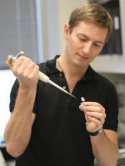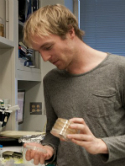rahu is a mutant allele of Dnmt3c, encoding a DNA methyltransferase homolog required for meiosis and transposon repression in the mouse male germline Journal Article
| Authors: | Jain, D.; Meydan, C.; Lange, J.; Claeys Bouuaert, C.; Lailler, N.; Mason, C. E.; Anderson, K. V.; Keeney, S. |
| Article Title: | rahu is a mutant allele of Dnmt3c, encoding a DNA methyltransferase homolog required for meiosis and transposon repression in the mouse male germline |
| Abstract: | Transcriptional silencing by heritable cytosine-5 methylation is an ancient strategy to repress transposable elements. It was previously thought that mammals possess four DNA methyltransferase paralogs—Dnmt1, Dnmt3a, Dnmt3b and Dnmt3l—that establish and maintain cytosine-5 methylation. Here we identify a fifth paralog, Dnmt3c, that is essential for retrotransposon methylation and repression in the mouse male germline. From a phenotype-based forward genetics screen, we isolated a mutant mouse called ‘rahu’, which displays severe defects in double-strand-break repair and homologous chromosome synapsis during male meiosis, resulting in sterility. rahu is an allele of a transcription unit (Gm14490, renamed Dnmt3c) that was previously mis-annotated as a Dnmt3-family pseudogene. Dnmt3c encodes a cytosine methyltransferase homolog, and Dnmt3c rahumutants harbor a non-synonymous mutation of a conserved residue within one of its cytosine methyltransferase motifs, similar to a mutation in human DNMT3B observed in patients with immunodeficiency, centromeric instability and facial anomalies syndrome. The rahu mutation lies at a potential dimerization interface and near the potential DNA binding interface, suggesting that it compromises protein-protein and/or protein-DNA interactions required for normal DNMT3C function in vivo. Dnmt3c rahumutant males fail to establish normal methylation within LINE and LTR retrotransposon sequences in the germline and accumulate higher levels of transposon-derived transcripts and proteins, particularly from distinct L1 and ERVK retrotransposon families. Phylogenetic analysis indicates that Dnmt3c arose during rodent evolution by tandem duplication of Dnmt3b, after the divergence of the Dipodoidea and Muroidea superfamilies. These findings provide insight into the evolutionary dynamics and functional specialization of the transposon suppression machinery critical for mammalian sexual reproduction and epigenetic regulation. © 2017 Jain et al. |
| Journal Title: | PLoS Genetics |
| Volume: | 13 |
| Issue: | 8 |
| ISSN: | 1553-7390 |
| Publisher: | Public Library of Science |
| Date Published: | 2017-08-30 |
| Start Page: | e1006964 |
| Language: | English |
| DOI: | 10.1371/journal.pgen.1006964 |
| PROVIDER: | scopus |
| PUBMED: | 28854222 |
| PMCID: | PMC5607212 |
| DOI/URL: | |
| Notes: | Article -- Export Date: 2 October 2017 -- Source: Scopus |
Altmetric
Citation Impact
BMJ Impact Analytics
Related MSK Work









